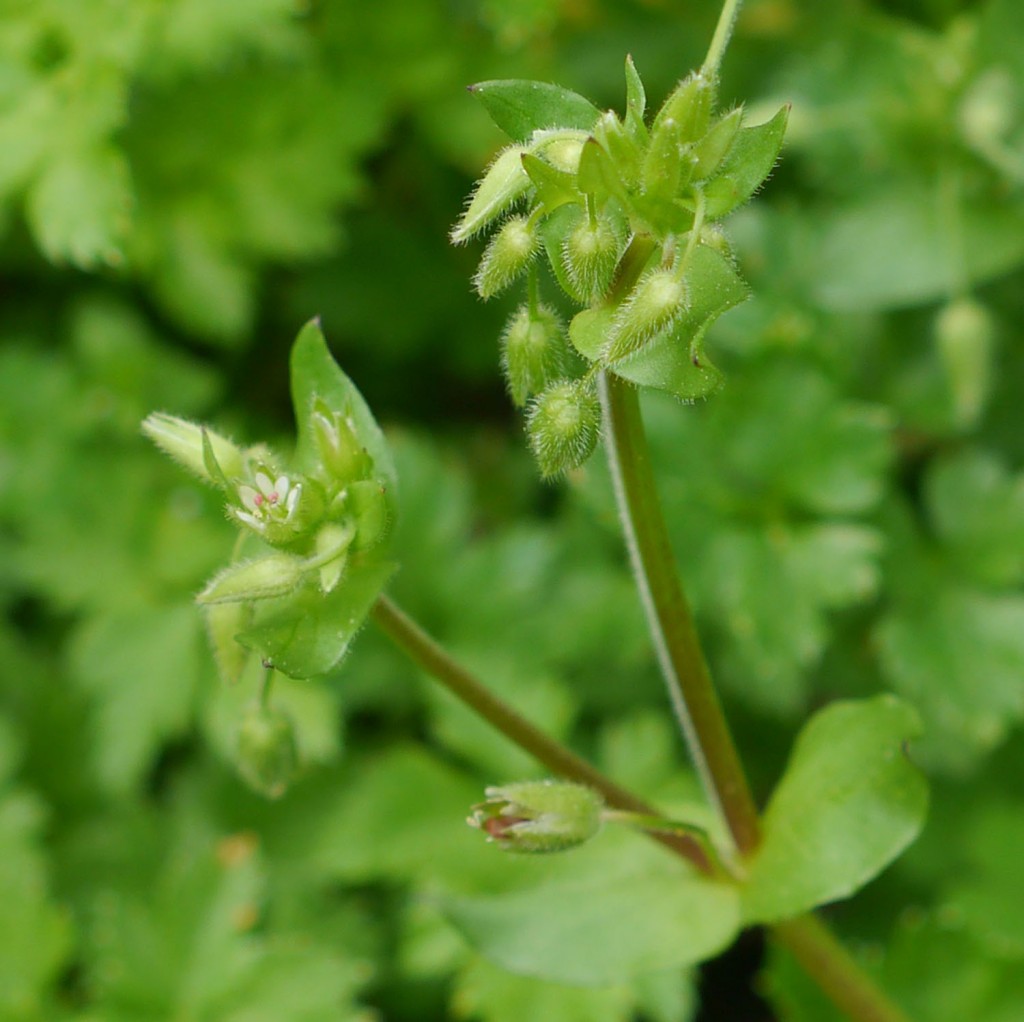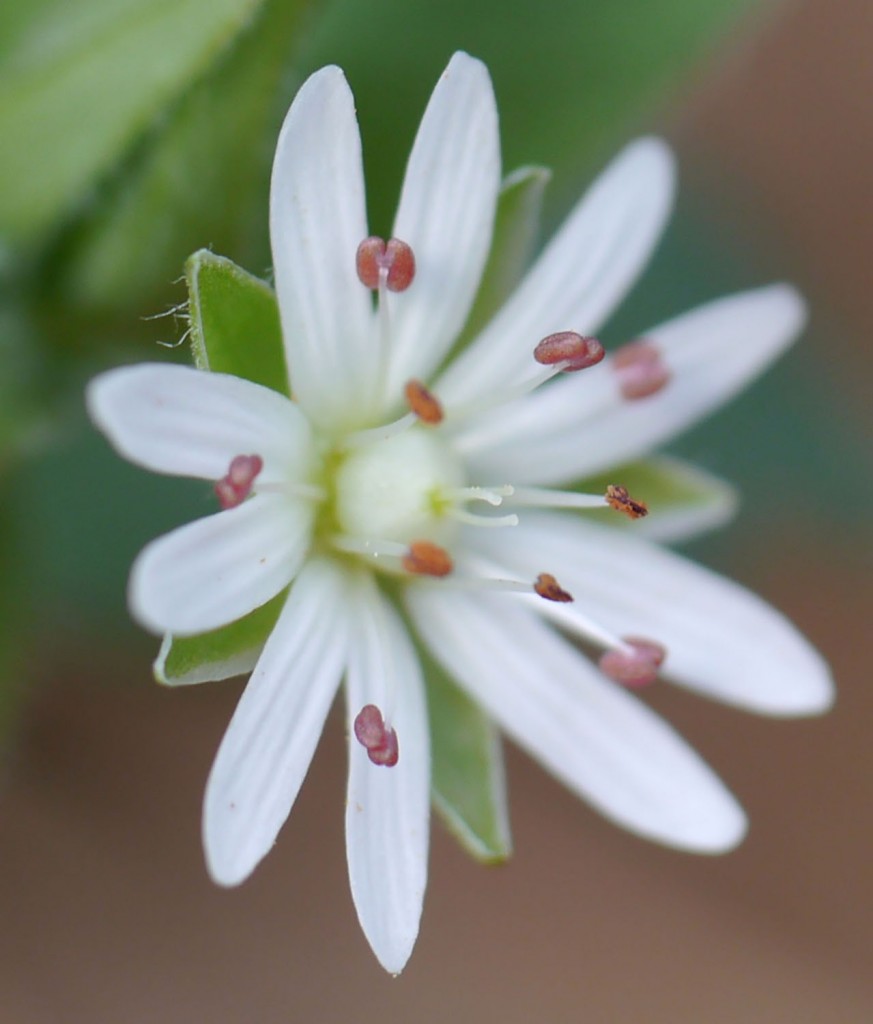 Common chickweed (Stellaria media) is “common” throughout significant portions of the world. This post compares Common chickweed with Star chickweed (Stellaria pubera). The next photo shows Common chickweed as a young plant.
Common chickweed (Stellaria media) is “common” throughout significant portions of the world. This post compares Common chickweed with Star chickweed (Stellaria pubera). The next photo shows Common chickweed as a young plant.
 Notice the shape of the leaves — as well as the petioles. As Common chickweed matures, the leaves at the end of the stalk do not have petioles. The leaf also gets a bit more interesting in its overall shape. The leaf margin remains entire.
Notice the shape of the leaves — as well as the petioles. As Common chickweed matures, the leaves at the end of the stalk do not have petioles. The leaf also gets a bit more interesting in its overall shape. The leaf margin remains entire.
 This younger plant’s stalk demonstrates the hairs growing in a line along the stem and up the petioles. You can also see the leaves are opposite with pinnate venation.
This younger plant’s stalk demonstrates the hairs growing in a line along the stem and up the petioles. You can also see the leaves are opposite with pinnate venation.
 If you study the above image carefully, you will notice the line of hairs changes position along the stalk at each node. It’s like the hairs spiral up the length of the stalk. In the next photo, you can see another identifying characteristic of Common chickweed — the inner core which reveals itself when you pull on the stalk. This is easiest to demonstrate with a young plant vs. a mature plant.
If you study the above image carefully, you will notice the line of hairs changes position along the stalk at each node. It’s like the hairs spiral up the length of the stalk. In the next photo, you can see another identifying characteristic of Common chickweed — the inner core which reveals itself when you pull on the stalk. This is easiest to demonstrate with a young plant vs. a mature plant.
 As the Common chickweed plant grows, it develops many stalks from the same base root system. It thickly covers an area.
As the Common chickweed plant grows, it develops many stalks from the same base root system. It thickly covers an area.
 It begins to grow its flower buds at the end of each stalk. The buds are covered with fine hairs.
It begins to grow its flower buds at the end of each stalk. The buds are covered with fine hairs.
 The flowers begin to open . . .
The flowers begin to open . . .
 . . . and we can see the sepals are as long as — and even a tiny bit longer than — the petals of Common chickweed’s flower.
. . . and we can see the sepals are as long as — and even a tiny bit longer than — the petals of Common chickweed’s flower.
 Let’s take a very close look at an open flower of Common chickweed:
Let’s take a very close look at an open flower of Common chickweed:
 Notice the yellow pollen grains on most of the anthers, the single pistil with its intricately topped style, and the hairy sepals supporting each petal.
Notice the yellow pollen grains on most of the anthers, the single pistil with its intricately topped style, and the hairy sepals supporting each petal.
Turning to Star chickweed, a woodland wildflower which blooms in early spring, we can see the overall plant does not get as full as Common chickweed.
 Star chickweed’s scientific name is Stellaria pubera. “Stellaria” for the star-shaped flower. And “pubera” for the hairiness of the entire plant. Notice the fine hairs covering the leaves, circumference of the stalk, and the flower buds.
Star chickweed’s scientific name is Stellaria pubera. “Stellaria” for the star-shaped flower. And “pubera” for the hairiness of the entire plant. Notice the fine hairs covering the leaves, circumference of the stalk, and the flower buds.
 The leaves (with entire margins) grow opposite each other on this plant — similar to Common chickweed. However, Star chickweed’s leaves are lanceolate — quite different from the shape of Common chickweed’s leaves.
The leaves (with entire margins) grow opposite each other on this plant — similar to Common chickweed. However, Star chickweed’s leaves are lanceolate — quite different from the shape of Common chickweed’s leaves.
 If you pull on Star chickweed’s stalk, the outer covering is much stiffer than with Common chickweed. Yet, it is possible to reveal the inner core of the stalk.
If you pull on Star chickweed’s stalk, the outer covering is much stiffer than with Common chickweed. Yet, it is possible to reveal the inner core of the stalk.
 Here’s a Star chickweed flower just beginning to open. You can see the anthers (dark spots) peeking out and rising above the white petals.
Here’s a Star chickweed flower just beginning to open. You can see the anthers (dark spots) peeking out and rising above the white petals.
 This next image demonstrates the sequential blooming process for Star chickweed. This shows developing flower buds in two stages, a flower beginning to open, and a fully opened flower.
This next image demonstrates the sequential blooming process for Star chickweed. This shows developing flower buds in two stages, a flower beginning to open, and a fully opened flower.
 Study the flower carefully. It has five deeply cleft petals (not ten), stamens, and a single ovary with three fine white styles arising from the center.
Study the flower carefully. It has five deeply cleft petals (not ten), stamens, and a single ovary with three fine white styles arising from the center.
 You can see those three white styles in the above image, the next image, and most clearly in the third Star chickweed image above.
You can see those three white styles in the above image, the next image, and most clearly in the third Star chickweed image above.
 This very close image illustrates several intriguing details: (1) sepals shorter than the petals, (2) five white deeply cleft petals, (3) anthers in different stages (plump, used-up, shriveling and shriveled) and (4) three white styles arising from the center above the single ovary.
This very close image illustrates several intriguing details: (1) sepals shorter than the petals, (2) five white deeply cleft petals, (3) anthers in different stages (plump, used-up, shriveling and shriveled) and (4) three white styles arising from the center above the single ovary.
The flowers of Star chickweed are twice the size of Common chickweed’s flowers. The two photos on the left of this composite image are Common chickweed (Stellaria media) while the two on the right are Star chickweed (Stellaria pubera).
 Lastly, here’s more useful information about Common chickweed and its relatives.
Lastly, here’s more useful information about Common chickweed and its relatives.

Wow!!!!! Your presentation was superb! This is how all learning should be. There should be no doubt in identification after viewing your site. Thanks a Bunch.
Awesome! Very detailed
I am striving to identify wild edible plants that my neighbors from Thailand often come in our common area to forage. They do not speak English, and shared some of their plants with me. I thought they might be common chickweed, but your very detailed pictures show me that they are not. Perhaps they are chickweed…just not common! Please help me to identify the plants. I live in Clarkston GA. I don’t know anyone here to ask!
Linda, I’ve sent you an email message. Perhaps we can work something out.
What are the different types of chickweed.
This post included two types of chickweed — Common and Star. If you want to find more species, I suggest doing a search on Stellaria (the genus name).
Thanks for this great post!
Thank-you so much for this detailed and beautiful post. I can tell you LOVE plants! I spent hours in books, on-line, and on Facebook trying to identify the chickweed in my yard, which was fully fuzzy with lanceolate clasping leaves. I could not find a definitive and authoritative answer. Here it is :-). I absolutely love your photos pointing out the uniqueness between the chickweeds. Very nice work.
Pingback: All You Need to Know About Chickweed | A Better Way to Thrive